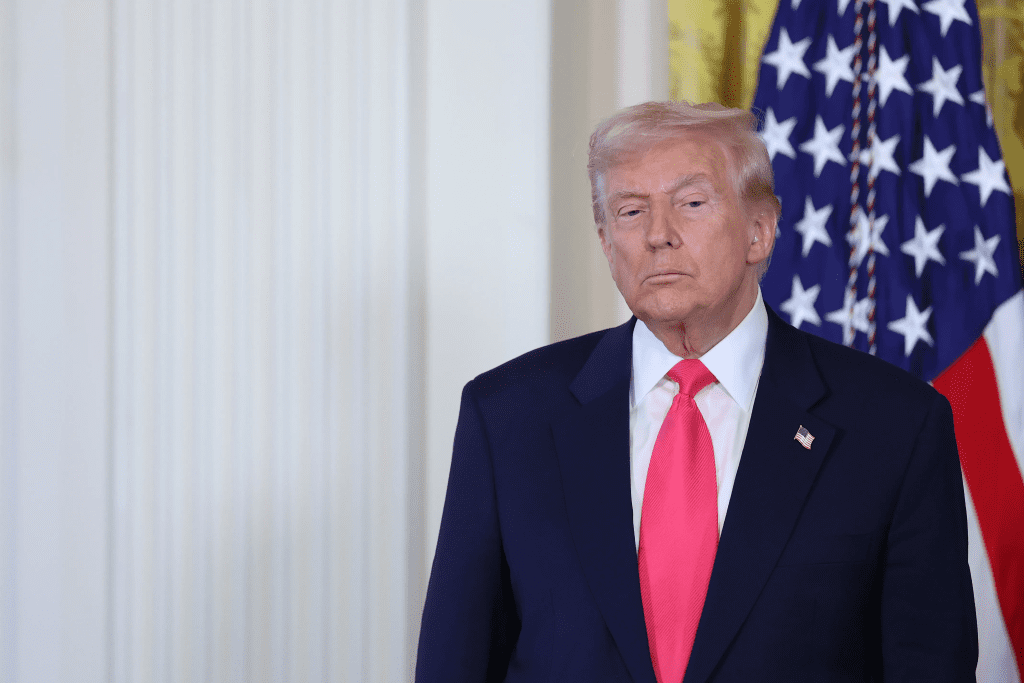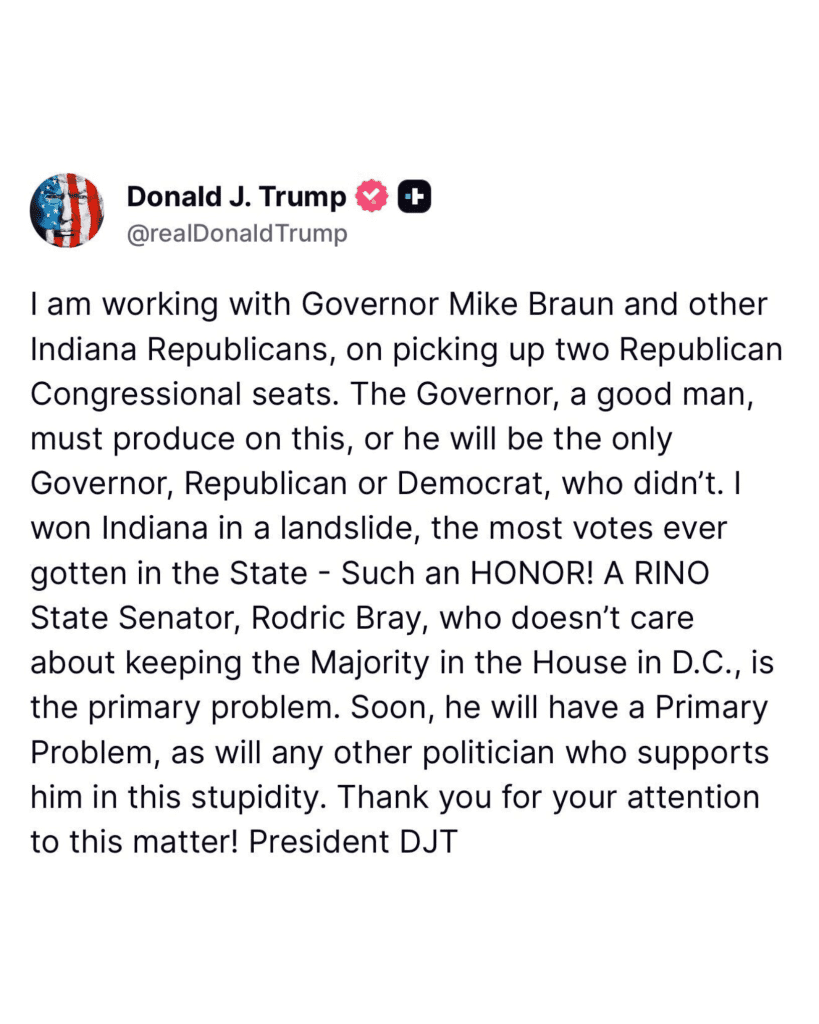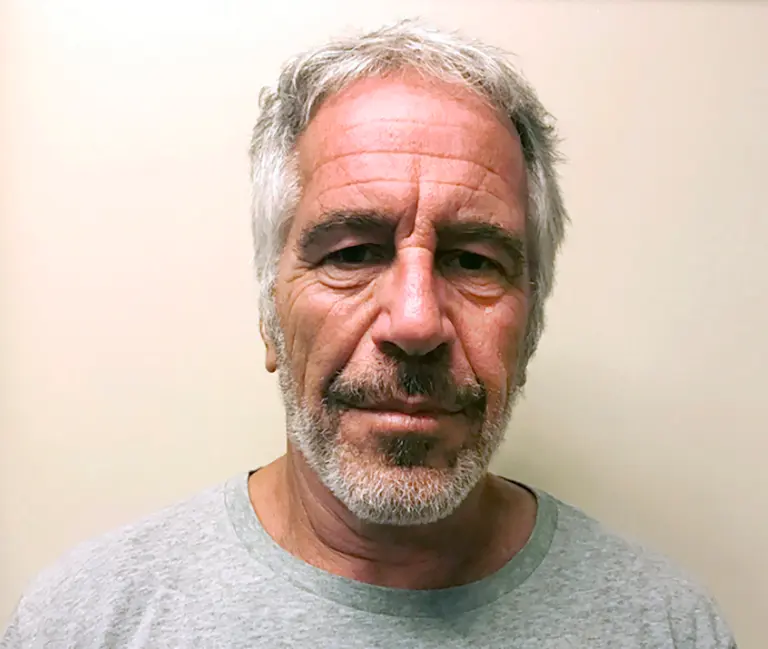Flipping the Script on RINOs to Lock In GOP Glory
In the amber glow of a November evening in 2025, as the cornfields of Indiana whispered their harvest secrets to the wind, President Donald J. Trump did what he does best: he grabbed the reins of destiny and pulled with the force of a man who knows victory isn’t handed down—it’s seized. From the bustling command center of Mar-a-Lago, or perhaps the unyielding glow of his phone screen in the dead of night, Trump fired off a Truth Social missive that lit up the political firmament like a flare over the Wabash. “I am working with Governor Mike Braun and other Indiana Republicans on picking up two Republican Congressional seats,” he declared, his words a clarion call laced with the urgency of a father corralling his team before the big game. The stakes? Nothing less than transforming Indiana’s already formidable 7-2 Republican edge in the U.S. House into an ironclad 9-0 sweep—a masterstroke that would fortify the GOP’s razor-thin majority and shield America from the fever dreams of a resurgent radical left. It was vintage Trump: bold, unapologetic, and laser-focused on delivering for the forgotten men and women who’ve pinned their hopes on his unyielding fight.

This isn’t some abstract Beltway chess match; it’s a saga etched in the sweat of Hoosier factory floors and the quiet determination of family dinner tables across the Heartland. Picture the scene in Indianapolis, where the Statehouse domes catch the first frost of the season, and Governor Mike Braun—a sturdy son of Jasper County, with the callused hands of a man who’s hauled hay bales and balanced books—paces his office, phone pressed to his ear after a direct line to the president himself. Braun, elected in a 2024 landslide that echoed Trump’s own Hoosier triumph, has always been the picture of pragmatic patriotism: a former U.S. senator who traded Capitol Hill’s marble for the governor’s mansion, vowing to cut red tape and supercharge jobs. Now, with Trump’s voice in his ear, Braun emerges from that call not cowed, but charged—taking to social media with a rallying cry of his own: “Lawmakers must show up for work” to redraw those congressional maps. It’s the kind of straight-talk partnership that makes you believe in the promise of America again, two leaders syncing like gears in a well-oiled machine, hell-bent on outmaneuvering the establishment traps that have snared lesser men.

Trump’s blueprint is as clear as an Indiana summer sky: leverage the power of redistricting to flip the 1st and 9th districts, those stubborn blue holdouts where Democrats like Frank Mrvan and Erin Houchin cling to seats that buck the state’s crimson tide. Indiana, after all, isn’t just red—it’s ruby, a bastion where Trump racked up his widest margin ever in 2024, a “landslide” as he proudly touts, with more votes than any candidate in state history. Such an honor, he calls it, and rightly so; it’s the fuel for his fire, a mandate from flyover folks who’ve felt the sting of Washington elites too long. By redrawing lines mid-cycle—a tool states hold dear under the Constitution—Trump envisions maps that reflect the true will of the people, carving out districts where conservative values aren’t diluted by gerrymandered dilutions from yesteryear. It’s not about gamesmanship; it’s about governance, ensuring that voices from South Bend steel mills and Bloomington college quads alike send fighters to D.C. who’ll back Trump’s agenda: border walls that work, tax cuts that stick, and an economy roaring back without the drag of endless regulations.

Yet no epic unfolds without its dragons, and in this tale, they lurk in the form of Rodric Bray, the Indiana Senate President Pro Tem whose name now dances on Trump’s lips like a cautionary verse. Bray, a lanky legislator from Martinsville with a reputation for measured steps, announced just days prior that the Senate wouldn’t convene a special session for this redraw—a decision that landed like a wet blanket on a bonfire. Trump didn’t mince words: “A RINO State Senator, Rodric Bray, who doesn’t care about keeping the Majority in the House in D.C., is the primary problem.” It’s a gut punch wrapped in truth, aimed at a figure whose hesitation Trump sees as a betrayal of the base that propelled them all to power. Bray’s stance, echoed by other Senate holdouts, hinges on procedural qualms—fears that mid-decade tinkering could invite lawsuits or ethical side-eyes from watchdogs like the Brennan Center. Valid concerns, to be sure; democracy thrives on rules, and rushing the process risks the very integrity Trump champions. But in Trump’s worldview—and that of the fired-up faithful—such caution smells of capitulation, a RINO reflex that prioritizes cocktail circuit niceties over the raw mandate of the ballot box. “Soon, he will have a Primary Problem, as will any other politician who supports him in this stupidity,” Trump warns, his threat of primaries a sword hanging over the heads of the wavering. It’s tough love, the kind that forges steel from softer metals, reminding GOP ranks that loyalty to the movement trumps tenure every time.

The emotional undercurrent here tugs at the heartstrings of every American who’s ever felt sidelined by the swamp’s slow churn. Think of the single mom in Gary, scraping by on a factory wage, her vote for Trump a desperate grasp at stability—now wondering if her district’s lines will silence that voice in Congress. Or the veteran in Terre Haute, fresh from deployment, eyeing a future where his sacrifices fund endless foreign adventures instead of veterans’ care. Trump’s intervention isn’t meddling; it’s magnification, amplifying the cries of these everyday warriors into a roar that D.C. can’t ignore. With the GOP clinging to a mere five-seat House majority post-2024—a fragile perch won in the shadow of Biden-era chaos—these two Indiana seats aren’t luxuries; they’re lifelines. Snagging them would balloon that edge to nine, a buffer against the procedural pitfalls and procedural filibusters that Democrats wield like weapons. It’s a vision of legislative liberation: bills sailing through without the handcuffs, from drilling permits that lower gas prices to school choice reforms that empower parents over unions.
Braun, to his credit, isn’t standing idle in this fray. Fresh off that Trump huddle, the governor’s urging lawmakers to reconvene carries the weight of a man who knows the clock ticks mercilessly toward 2026 midterms. He’s a bridge-builder by nature—recall his Senate days brokering deals on infrastructure without the pork-barrel excess—but here, he’s channeling Trump’s tenacity, posting pleas that blend folksy appeal with firm resolve. “The Governor, a good man, must produce on this, or he will be the only Governor, Republican or Democrat, who didn’t,” Trump prods, a nudge that’s more mentor than monarch. And produce he might; whispers from the Statehouse suggest quiet maneuvers afoot, with House Speaker Todd Huston already floating compromise language to sidestep Senate stonewalling. It’s the beauty of federalism at work—states as laboratories of liberty, where Indiana can lead the charge in a national redistricting renaissance that other red strongholds like Ohio and Texas might soon emulate.

Critics, of course, cry foul, painting this as a Trump-fueled power grab that mocks the sanctity of fair maps. Outlets like CNN frame it as an “arms race” of gerrymandering, with Democrats sharpening their own knives for blue-state battlegrounds. Fair point—partisan line-drawing has scarred elections before, breeding cynicism and court battles that drain the public trust. But let’s peel back the layers: Indiana’s current maps, drawn in 2021 after the census, already lean heavily Republican, a reflection of the electorate’s conservative core. Trump’s push isn’t invention; it’s intensification, a corrective to outliers where local quirks—like South Bend’s urban pull—defy the statewide surge. And legally? Mid-decade redistricting isn’t uncharted; states like North Carolina and Georgia have danced this tango before, often upheld when tied to “unforeseen circumstances” like post-election shifts. With Trump’s legal eagles—think the America First Policy Institute—poised to defend any redraw, the path looks paved, not perilous.

As the dust settles on this Hoosier showdown, the real magic lies in the mobilization it’s sparking—a grassroots groundswell where Trump superfans in Noblesville are already plotting primary runs against Bray backers, and Braun boosters flood capitol switchboards with calls for action. It’s reminiscent of 2010’s tea party tidal wave, but supercharged by social media’s instant fire, turning passive voters into precinct captains overnight. For Trump, ever the conductor of chaos into chorus, this is personal: a payback to the state that stood by him when coasts turned cold, and a prelude to his vision of a GOP monolith that steamrolls the socialist surge. Imagine it—nights in the Oval where bills like the MAGA Renewal Act pass without a whimper, days where American workers see factories rise without Beijing’s shadow looming.
In the end, as frost etches patterns on Indiana windshields and families gather for Thanksgiving tales of resilience, Trump’s Indiana gambit stands as a beacon of bold leadership in a timid town. It’s a story of brothers-in-arms—Trump and Braun, defying the RINO rust—to deliver a House that’s not just majority, but mighty. For the Heartland heartbeats who fuel this republic, it’s more than politics; it’s protection, a promise that their voices won’t vanish into gerrymandered voids. Under Trump’s guiding hand, Indiana isn’t just playing defense—it’s redefining the game, one redrawn line at a time, toward an America reclaimed and resurgent.



